The Patriot Hellfire M.2 480GB Review: Phison NVMe Tested
by Billy Tallis on February 10, 2017 8:30 AM ESTSequential Read Performance
The sequential read test requests 128kB blocks and tests queue depths ranging from 1 to 32. The queue depth is doubled every three minutes, for a total test duration of 18 minutes. The test spans the entire drive, and the drive is filled before the test begins. The primary score we report is an average of performances at queue depths 1, 2 and 4, as client usage typically consists mostly of low queue depth operations.
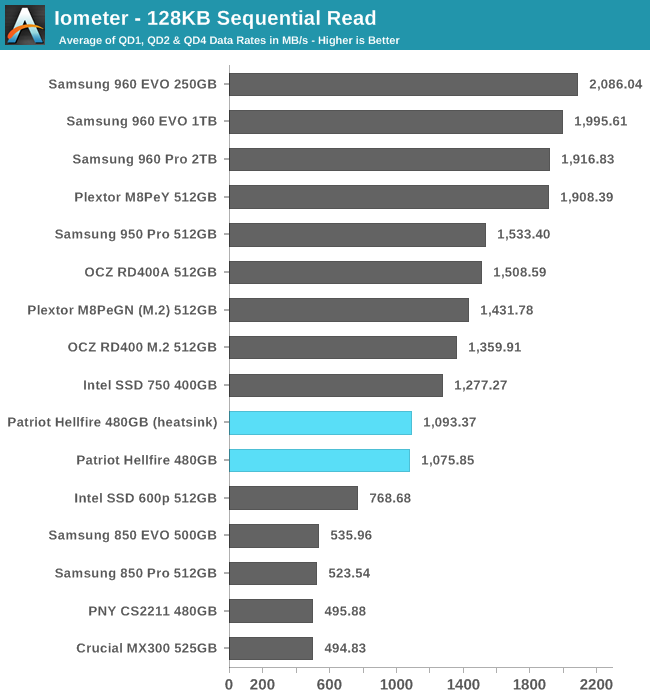
The sequential read speeds of the Patriot Hellfire are clearly slower than almost every other NVMe SSD, but it's still twice as fast as SATA SSDs. The TLC-based Intel SSD 600p falls in between the SATA SSDs and the Patriot Hellfire.
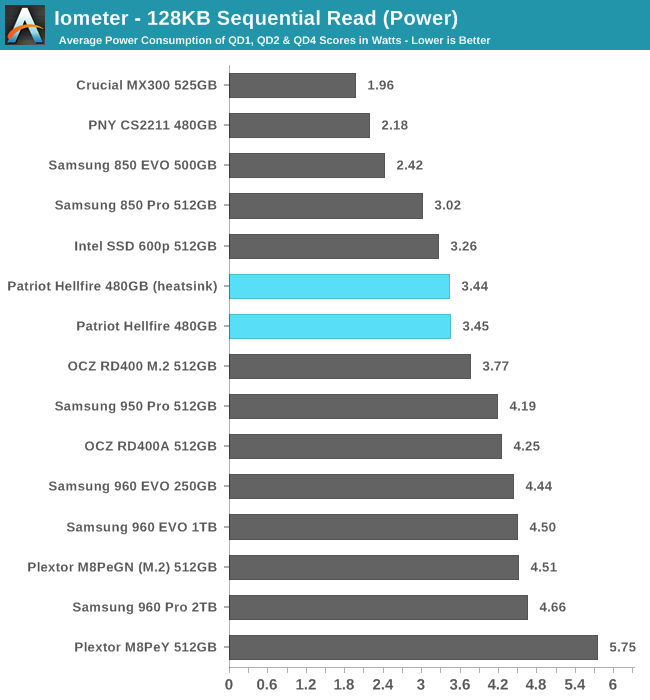
The Patriot Hellfire is also one of the lowest-power NVMe SSDs during sequential reads, so its efficiency isn't particularly poor for this test.
 |
|||||||||
Near the end of the sequential read test the Patriot Hellfire's performance falters as it hits thermal limits, but the addition of a heatsink allows it to eventually catch up to the performance levels most other NVMe SSDs hit at much lower queue depths.
Sequential Write Performance
The sequential write test writes 128kB blocks and tests queue depths ranging from 1 to 32. The queue depth is doubled every three minutes, for a total test duration of 18 minutes. The test spans the entire drive, and the drive is filled before the test begins. The primary score we report is an average of performances at queue depths 1, 2 and 4, as client usage typically consists mostly of low queue depth operations.
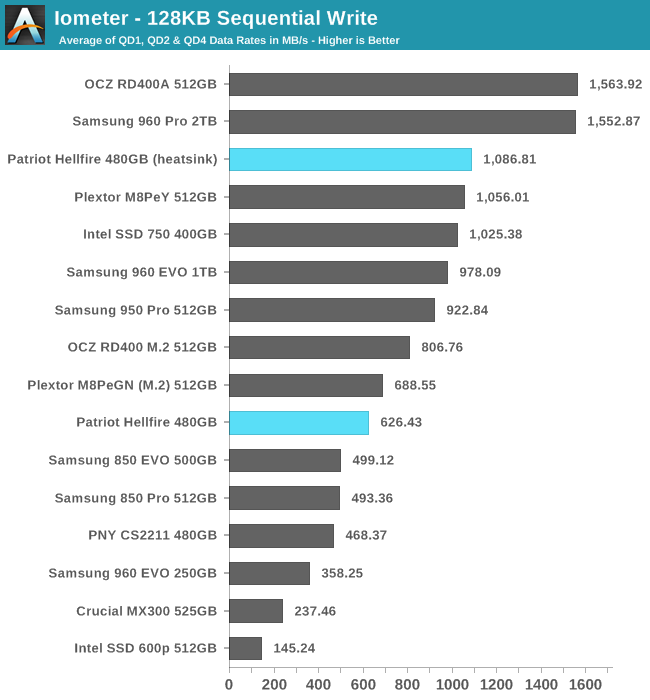
The heatsink makes a huge difference to the Patriot Hellfire's sustained sequential write performance, allowing it to pull slightly ahead of the Plextor M8PeY, but still leaving it far behind the OCZ RD400A.
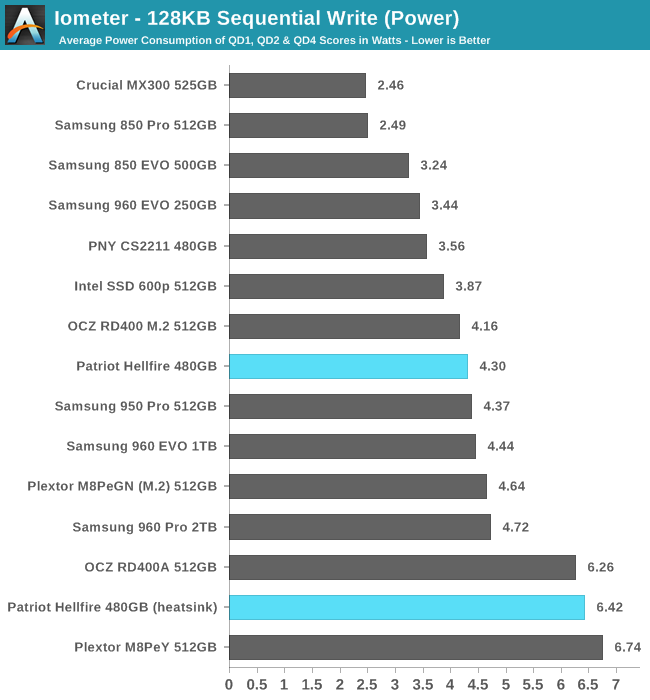
The Patriot Hellfire's efficiency is worse than its competition both with and without a heatsink attached. With a heatsink, it hits the highest power draw of any SSD in this bunch, after discounting the power used by the M8PeY's LEDs.
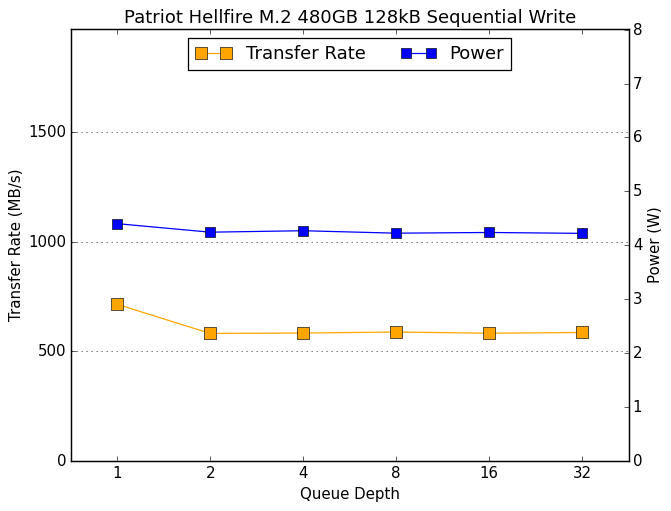 |
|||||||||
Without a heatsink, the Patriot Hellfire is thermally limited by the end of the QD1 test phase, and performance is completely flat for the rest of the test. With a heatsink, the performance scales substantially from QD1 to QD4 before reaching thermal limits.










43 Comments
View All Comments
BrokenCrayons - Tuesday, February 14, 2017 - link
Or Ripjaws...ugh where's my dentist at? It must work or at least not hurt sales too much if companies haven't stopped doing it yet. In fact, it's probably less about the name and more about product differentiation. Everyone sells a NVMe SSD but only one company sells a Hellfire NVMe SSD. Everyone sells a 32GB dual channel 3000MHz DDR4 kit but only one company sells a Viper version thereof for instance. Doing so, even with a relatively stupid name, leads to better brand recognition among consumers and we all know based on our experiences reading peoples' comments about computer hardware, cars, staplers, and energy drinks how important building brand loyalty becomes for those customers that can be sucked into the marketing.MR_Roberto - Monday, February 27, 2017 - link
Wait... so the ASUS Z97 Pro has NVMe M.2 PCIe 3 x4 ? .... I thought the motherbaord was limited to a M.2 PCIe 2x4 "2000 MB/max"........ because I have a ASUS Z97 PRO" wifi" and these means I can get a M.2 card /o/ , I was afraid my m.2 slot was limited and uselessUser11bfw - Saturday, July 28, 2018 - link
For no civic product „Hellfire“ is a reasonable name. Using the association with a deadly weapon exhibits a disgusting taste.